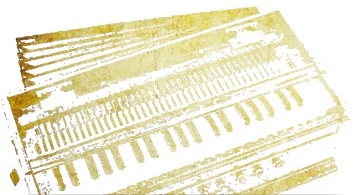
|
Acoustics of Harmonium Reeds
 posted by Daniel on January 20th, 2012
posted by Daniel on January 20th, 2012
|
What physical aspects of the
harmonium contribute to its beloved characteristic sound? And how can those physical aspects be improved, to enhance and make more consistent that sound?
Over the last few years, I have often found myself fussing over and pondering harmonium reeds. They are one of the more common parts in the Indian-made harmoniums to fail, usually by going out of alignment and causing a grating, metallic buzzing sound. They are also, however, the essential component that leads to the vibrant, reedy, sustained tone of the harmonium.
Other instruments, such as a guitar, cello or piano, rely on their wood selection and wood craftsmanship for their tone. For these instruments, a string initially produces the tone, but the string itself is quite thin and very quiet (think of strumming an electric guitar when the volume is off). And so these instruments have "sound boards" and "resonating chambers" built in to their design, to pick up the quiet string's note, and amplify it many fold.
For a harmonium, however, the wooden box is not a sound board, it is mostly a structural encasement for the inner parts, such as the hidden secondary bellows which expands to fill the lower half of the harmonium's box. For a harmonium, it's the reeds that determine its tone, in combination with the small channel the reed plays through, hidden at the back of each key on the keyboard.
Last week, I took apart an old Hohner harmonica (harmonicas, along with accordions, are the closest living relatives of the harmonium), in hopes of gaining new insights about how to improve harmonium reeds. Then I stumbled on to a community of custom harmonica builders, who helped me understand two critical aspects of the acoustics of vibrating musical reeds:
First, the metal reed must be situated in its reed box (the small, sturdy brass rectangle around the reed) with the smallest possible tolerances. The harmonica customizers were praising one reed maker who brought the tolerances down to .0005" (a tiny fraction of an inch), made possible by advanced computer-aided machining techniques. With that tiny a gap around the reed, very little air is being lost. This not only makes the bellows generally more efficient, but more critically, gets the reed vibrating quicker. This is called "responsiveness," and it's a thing I've noticed severely lacking in many Indian-made harmoniums. Before now I've never understood what caused it - even after all leaks in the bellows and boxes are cured, such harmoniums still aren't very responsive. You press a key down, and it takes a half a second before sound is coming out. What I can see now (physically see - open up a harmonium and you'll see plenty of light shining between the reeds and their reed boxes) is that when reeds aren't made with fine tolerances with regard to their reed boxes, responsiveness goes downhill.
Second, the type of metal and thickness profile of the reed must make it as close to "ideal" a spring as possible. An "ideal" spring oscillates with a "simple harmonic motion." Such a vibrating object has a unique property that suits it for music making - namely, that no matter how much force it is played with (i.e. loud or soft), its frequency is the same. Interestingly, this is not true for most physical objects. Can you imagine playing a middle C on the piano... and playing it harder, it goes a bit flat, and playing really hard it goes very flat? Gosh that would be awful, and thankfully not the case - piano strings vibrate rather ideally, maintaining their pitch at all volumes. Unfortunately, that's not the case with the current state of harmonium reed design. When you play your harmonium softly, the reed is a bit sharp. Play it at a "normal" volume and it is as "in tune" as that particular harmonium can be. Play it loud, however, and the pitch (the frequency of vibrations) drops, causing the note to go flat.
My guess is that since harmonium reed-making technology got to India more than a century ago, the craftsmanship and purity of metal required have both been in decline. Today, it's hard to get harmonium reeds from the Indian makers that are in tune to begin with, but even those that are in tune have this frustrating property of going rather flat when played loudly. I wonder how much this could be mitigated by more precise thickness-profiles and better metal purity.
























